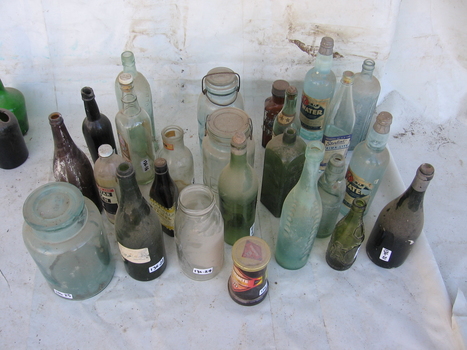Historical information
This collection represents late 19th and early 20th-century glass bottles, commonly used for household, medicinal, beverage, and food storage purposes.
Soda and mineral water bottles (tinted blue or green) were often sealed with marble stoppers (Codd bottles) or corks.
Alcohol and wine bottles were dark green or brown to prevent light exposure from spoiling the contents.
Apothecary and medicine bottles were embossed or labeled, sometimes with poison warnings.
Preserving jars with metal clamps were used for storing homemade preserves and pickled goods.
Food product containers, such as mustard or jam jars, were commonly reused for other household needs.
This collection likely originated from a rural homestead, a general store, or an apothecary, representing everyday life in the late 1800s to early 1900s.
Physical description
The image showcases a diverse collection of glass bottles and jars, varying in size, shape, colour, and purpose. The assortment includes:
Tall, slender bottles with narrow necks, likely used for soda, beer, spirits, or wine.
Shorter, rounded bottles, which may have contained tonics, medicine, or sauces.
Glass jars with metal lids, including one with a hinged clamp, suggesting use for preserves, pickles, or household goods.
Several bottles retain original labels, with one clearly marked "Water" and another labeled "Star", indicating they were originally used for beverages or medicinal products.
A rusted tin with a faded label, which appears to be an old food or medicinal container.
Some bottles exhibit embossed lettering, which was a common feature in 19th and early 20th-century packaging.
Most bottles are clear, green, or brown, with some appearing to have a blue tint, which was characteristic of early mineral water and soda bottles.
Some bottles have cork or screw tops, while others have open tops, suggesting they may have been sealed with wax or stoppers.
The collection appears to be a historical assortment, possibly from an old general store, apothecary, or household setting.




